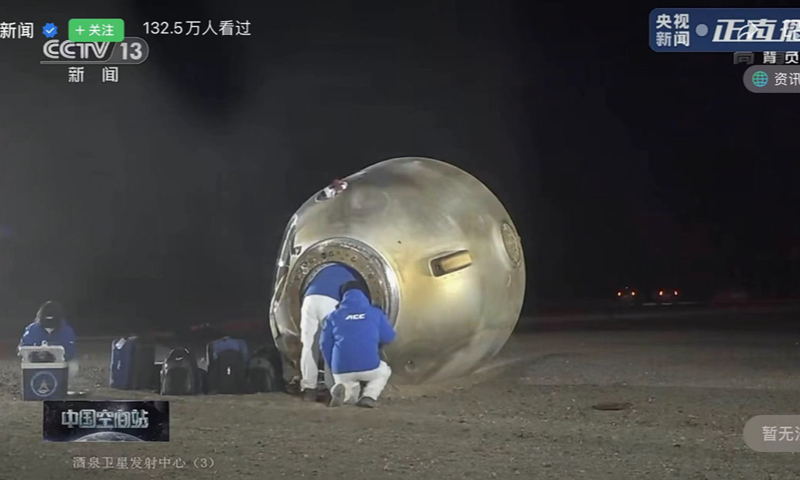
Photo: screenshot of CCTV
After concluding six-month stay at the China Space Station and completing first-ever direct handover in orbit in the country’s aerospace history, three taikonauts of the Shenzhou-14 manned spaceflight mission have safely returned to the Dongfeng landing site in the Gobi Desert, North China’s Inner Mongolia Autonomous Region on Sunday.
At 8:09 pm Sunday, the return capsule of the Shenzhou-14 manned spacecraft carrying three taikonauts conducted successful touchdown in the Dongfeng landing site. The medical personnel confirmed that the taikonauts were in good health, marking a complete success of the return mission, the Global Times has learned from the China Manned Space Agency (CMSA) on Sunday.
The Shenzhou-14 manned spacecraft successfully separated with the China Space Station combination at 11:01 am Sunday. Before their departure, the Shenzhou-14 crew, with the help of a local ground team, completed the handover with the Shenzhou-15 crew, and other tasks including downloading the experiment data, the CMSA said earlier.
“It marked the first return mission after the completion of China Space Station’s T-shape basic structure assembly, the first after gathering of six taikonauts at the space station, and also a first that has taken place in the winter night at the Dongfeng site,” Peng Huakang, the person-in-charge of the manned spacecraft recovery team with the spacecraft developer China Academy of Spacecraft Technology (CAST,) told the Global Times.
The return of the Shenzhou-14 manned spacecraft consisted of five stages before the final touchdown, including the separation of spacecraft from the space station, the braking maneuver, the re-entry to atmosphere and decelerating before landing.
Adopting a rapid return strategy similar to previous missions, the Shenzhou-14 craft rounded Earth only five times before making its re-entry. Then the orbiter capsule separated with the return capsule. And with the help of the propelling capsule in two braking maneuvers, the combination of the return capsule and propelling capsule then descended from 400-kilometer orbit to 100-kilometer one before their separation, the CAST explained in a statement provided to the Global Times.
The propelling capsule was burnt up during re-entry to the atmosphere and the return capsule took on a well-calculated trajectory to be headed back to Earth’s atmosphere and to the Dongfeng site.
Besides personal items, the "luggage" carried by the three taikonauts back also includes a batch of medical science experiment samples, mainly body fluid and cytology samples, which can allow the ground research team to better understand the changes inside human body during their life in space, the Global Times learned from the CMSA.
According to Li Yinghui, a researcher with the Chinese astronaut training system, the "luggage" includes astronauts' blood, urine, and saliva. Researchers can study human adaptability to the environment with in-depth, at the level of cells, molecules, and genes, which enables China to have its own genetic resource bank for environmental adaptation in orbit.
Search and rescue work for the Shenzhou-14 return capsule is of great significance in boosting China’s international image, as the task marks the conclusion to the construction stage of the China Space Station, Bian Hancheng, the deputy chief designer of the manned space project landing site system, told the Global Times.
China has signed agreements with more than a dozen countries and regions to carry out space experiment projects on the China Space Station, and this is the first time that space application system has participated in the search and rescue works at Dongfeng, according to Bian, who is also a senior engineer with the Jiuquan Satellite Launch Center in Northwest China’s Gansu Province. The task has opened a new normal for the landing site to recover space application payload from domestic and foreign customers, he said.
The biggest challenges facing the search and rescue mission s extreme cold and night conditions that could lead to most complicated and difficult situations, according to the Dongfeng landing site authorities.
Bian explained that it is more difficult to identify and locate the target craft at night than during daytime and it is also extra hard to arrive at the landing site, as landing a helicopter would be more difficult given the poor visibility of surroundings during the night time in remote Gobi Desert.
Dubbed the China Space Station’s busiest crew to date, Shenzhou-14 mission commander Chen Dong and his fellow crewmembers Liu Yang and Cai Xuzhe conducted three extravehicular activities or known as the spacewalks, delivered a new episode of the Tiangong Classroom space lecture sessions, carried out multiple space experiment and application projects, and above all, participated and witnessed the completion of the China Space Station’s three-module T-shape basic structure assembly.
They also greeted the incoming Shenzhou-15 crew on Wednesday, handing over the key to the China Space Station to the Shenzhou-15 taikonauts on Saturday, in addition to completing the country’s first-ever in-orbit work handover.
Moreover, Chen Dong the mission’s commander also became the first taikonaut to have worked and lived in orbit for more than 200 days during the Shenzhou-14 mission that lasted more 183 days. He previously worked in orbit for 33 days during the Shenzhou-11 mission in 2016.




